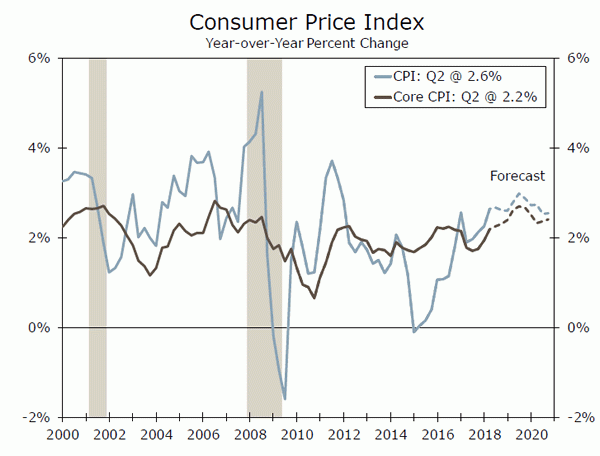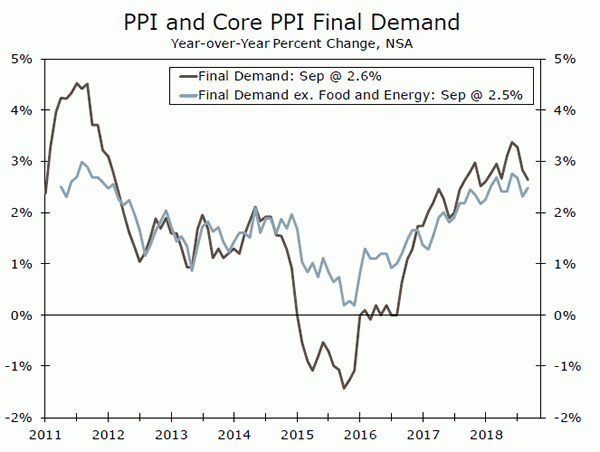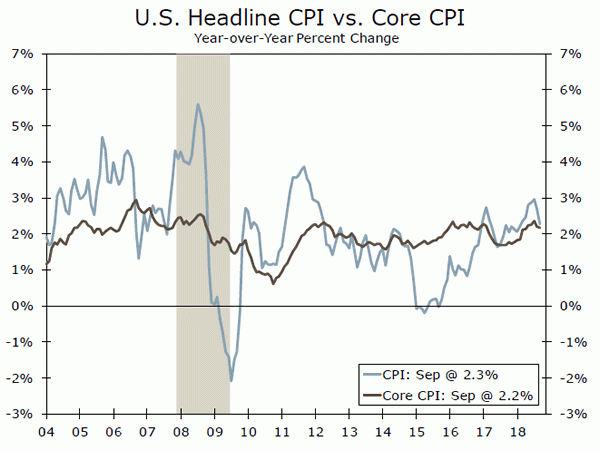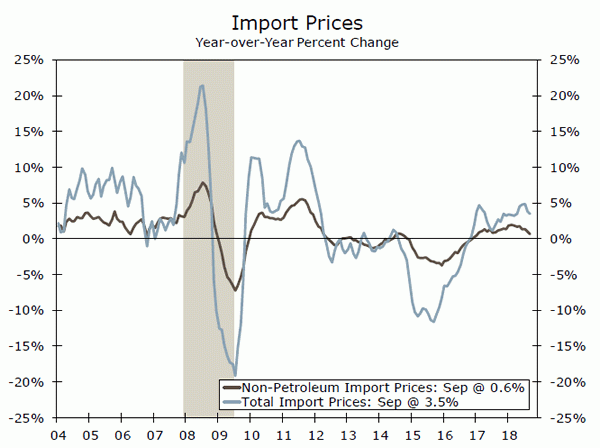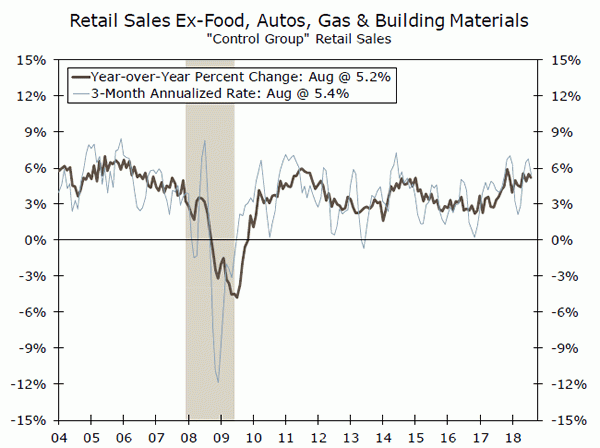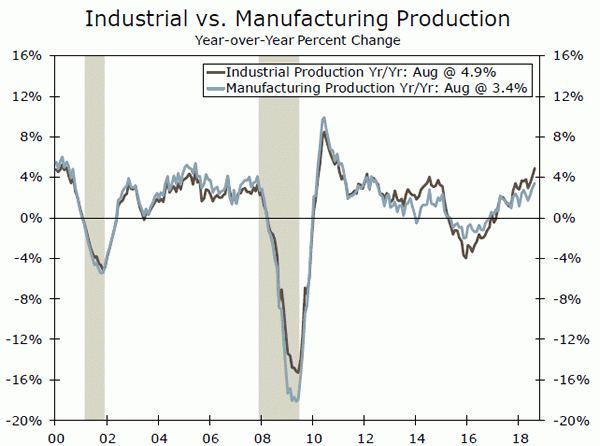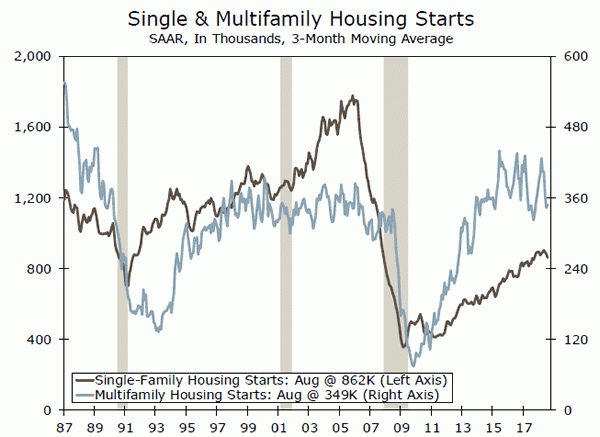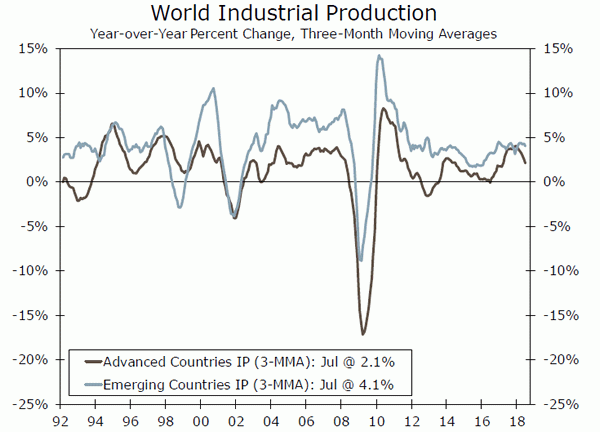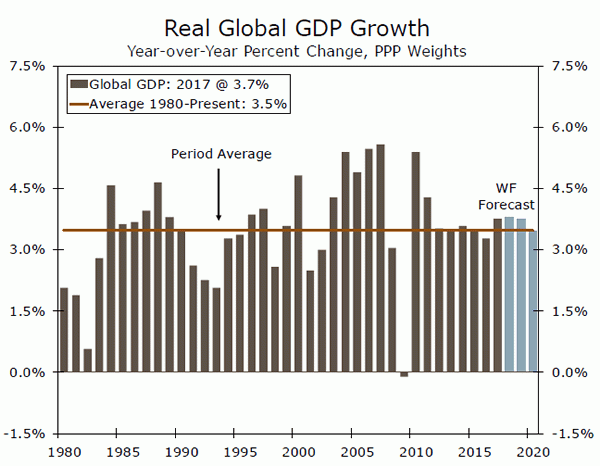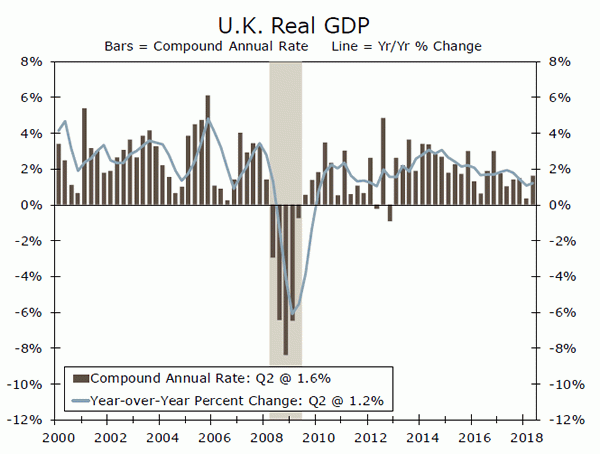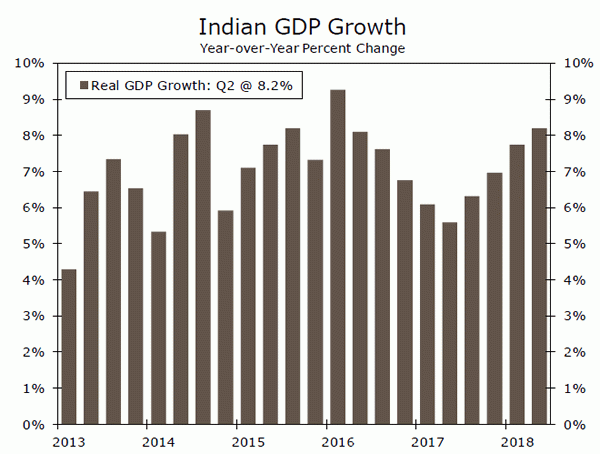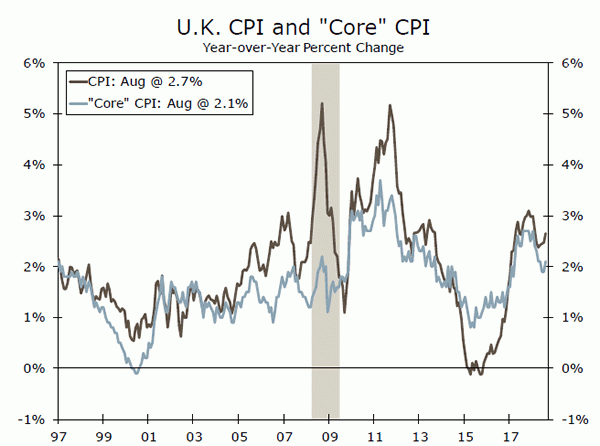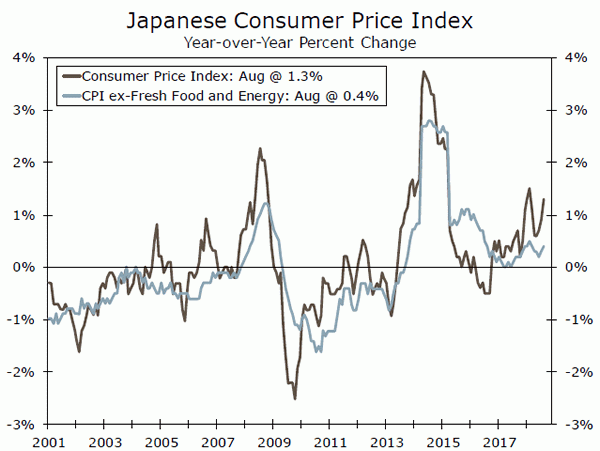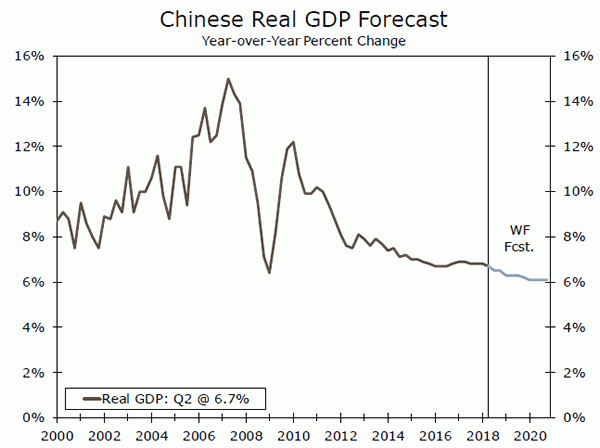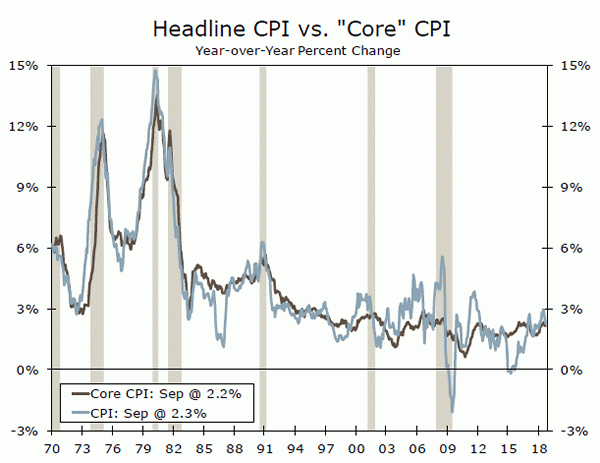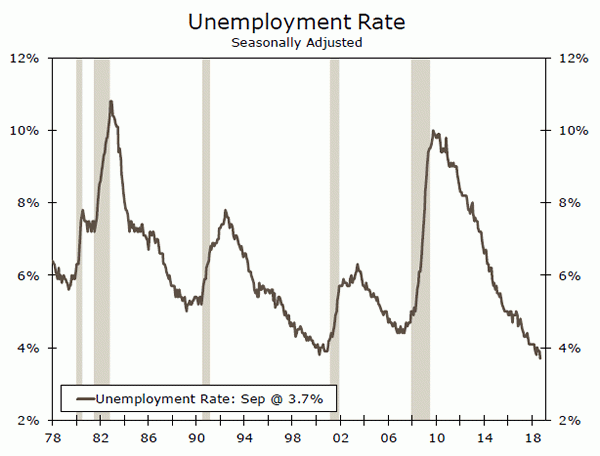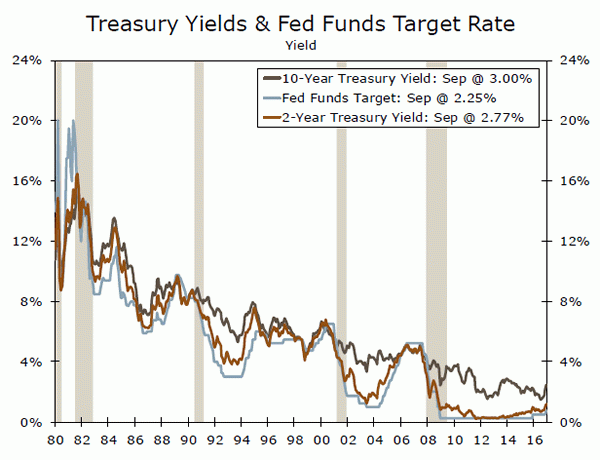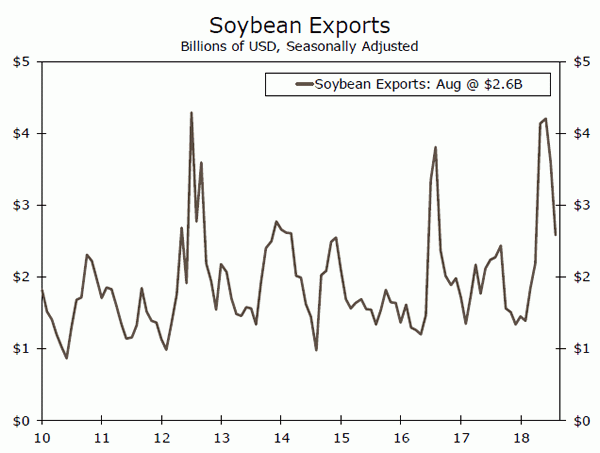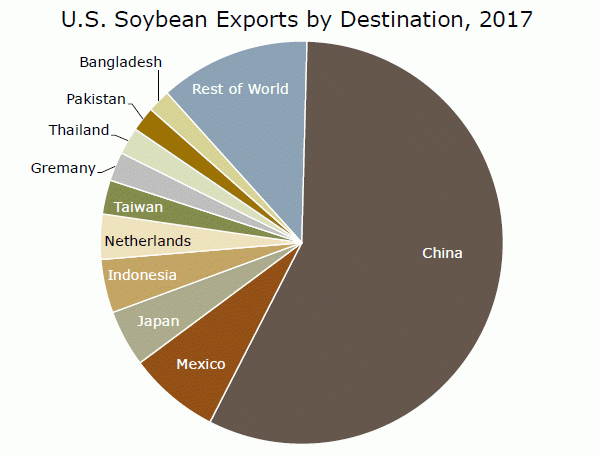U.S. Review
September Inflation Keeps Fed on Track
- While most of the fresh September inflation data came in more or less as we had expected, higher oil prices and recently enacted tariffs have caused us to increase our outlook for inflation.
- Due to the nature of the increase stemming from a one-time upward level shift in prices, we still see the Fed on track to raise rates once a quarter through Q3-2019.
- Producer prices rose 0.2%, while consumer prices were up a more modest 0.1%. A surge in petroleum prices caused import prices to rise 0.5% in September.
September Inflation Keeps Fed on Track
It was a quiet week in terms of economic data, but we did receive fresh September data for three inflation measures, the producer price index (PPI), the consumer price index (CPI) and the import price index. While most of the data came in more or less as we had expected, higher oil prices and recently enacted tariffs have caused us to increase our outlook for inflation. Due to the nature of the increase, we still see the Fed on track to raise rates once a quarter through the third quarter of 2019.
Producer prices rose 0.2% in September, but moderated to 2.6% on a year-over-year basis (top chart). The gain was led in large part by services, up 0.3% over the month, as transportation & warehousing prices rose a whopping 1.8%. This caused our preferred measure of core inflation, which excludes food, energy and trade services, to grow a larger-than-expected 0.4%. Over the past 12 months, however, “core-core” remained at 2.9%. With input prices running ahead of final prices, consumer price inflation will likely continue to gradually rise.
On the consumer front, prices came in a bit softer than expected, growing 0.1% for both the headline and core CPI measure. A 0.5% drop in energy held down headline inflation, while the similarly modest pick-up in core prices can be tied to a 0.3% drop in core goods. The weakness here was largely due to a 3.0% decrease in used auto prices. But, we do not expect this weakness to persist given the Manheim used car index has increased in recent months, and the recent hurricanes will likely spur replacement demand. Core services remained strong, however, up 0.2% over the month. While core inflation remained at 2.2% on a year-over-year basis, the headline CPI rose 2.3%, a more modest reading given the past few months, but in-line with the average rate over the past two years (middle chart).
Import prices rose 0.5% in September. Higher oil and food prices were behind the gain, however, as, excluding fuel, prices were flat and excluding both food and fuels, prices were down 0.1%. Over the past 12 months, import prices were up 3.5% (bottom chart).
Despite the mixed inflation data for September, higher oil prices and effects of the more recently enacted tariffs cause us to expect inflation to strengthen in coming months. We have upwardly revised our inflation forecast, and look for CPI to rebound to 2.6% in Q4, before climbing to 2.8% in 2019 (chart on page 1).
Supply and transportation constraints are causing oil prices to be higher than originally thought through the rest of this year and into next. While, unlike the initial round of tariffs, which were primarily concentrated on intermediate products, the more recent $200 billion of imports from China now subject to tariffs involve finished goods. Due to many businesses having price contacts in place, or some having the ability to absorb part of the increased costs, the impact of tariffs likely will be drawn out.
These dynamics likely will push up consumer prices in the final months of the year and into the first few months of 2019. However, while the lift stems from one-time upward level shifts in prices, we anticipate the Fed likely will look through the inflation pickup unless inflation expectations become unanchored.
U.S. Outlook
Retail Sales • Monday
Next week begins with another look at the strength and durability of consumer spending in the final month of Q3. The 0.1% August rise in headline retail sales missed expectations of a 0.4% rise, but prior months were revised significantly upward. That said, there is clear evidence that interest-rate-sensitive sectors of the economy are beginning to cool; August marked the third consecutive monthly decline in auto sales (one-fifth of retail sales). But, nine categories of spending still increased in August, with only furniture, clothing and department stores declining. There could also be a potential boost in September spending related to the aftermath of Hurricane Florence.
The balance of data still suggests that consumer spending will be supportive of above-trend GDP growth in Q3. Consumer confidence and small business optimism remain a shade off of all-time highs. With interest rates rising, consumers still see no time like the present to spend, and we expect retail sales to rise 0.6% in September.
Previous: 0.1% Wells Fargo: 0.6% Consensus: 0.7% (Month-over-Month)
Industrial Production • Tuesday
On Tuesday attention will shift to the industrial sector, where production was up a solid 0.4% in August. More impressive was the 4.9% year-over-year gain, which marked the strongest pace since 2010. Mining—14% of industrial production—saw an outsized gain of 14.1% year-over-year, as energy production has ramped up to record highs. Manufacturing output was more modest, up 0.2% on the month. However, business equipment production was up 1.2%, which bodes well for our call for real equipment spending to expand at around a 4% pace in Q3. The ISM Manufacturing survey has been sky high, and regional Fed surveys have also pointed to continued sector strength. We will also get some more insight into the nation’s industrial sector from the Empire Manufacturing survey on Monday.
Moving forward, we expect dollar appreciation, higher interest rates and trade uncertainty to weigh on equipment spending, which should moderate slightly in coming quarters.
Previous: 0.4% Wells Fargo: 0.2% Consensus: 0.2% (Month-over-Month)
Housing Starts • Wednesday
The week concludes with more data on the laggard housing market, with housing starts on Wednesday and existing home sales on Friday. Starts in August were up 9.2% on the month, but this was largely due to a 29.3% jump in the volatile multifamily category. Behind this noise, however, is perhaps a signal—that the underlying strength in apartment building has been a result of affordability and supply concerns limiting the ability of renters to buy. Furthermore, permits fell 5.7% in August and are now running below starts. This weakness in starts data contrasts with the ongoing sanguine readings from homebuilder surveys.
We still expect homebuilding to improve over coming quarters, but have taken down the degree of improvement in our forecast. Still, the remainder of the fall could see a rebound in starts. Lumber prices have fallen significantly from recent highs, and inventories of units authorized but not yet started continue to climb.
Previous: 1,282K Wells Fargo: 1,221K Consensus: 1,210K
Global Review
Global Growth Slightly Weaker Despite U.S. Strength
- In what was a relatively quiet week for international economic data, the International Monetary Fund (IMF) released its biannual World Economic Outlook.
- The IMF noted a theme we have highlighted in numerous recent reports: global growth has been a bit softer-thanexpected this year despite a robust showing from the United States.
- Encouragingly, the economic data of late have been a bit better out of some advanced economies, such as the United Kingdom, while despite the troubles in emerging markets there are some bright spots there as well, such as robust growth in India.
Global Growth Slightly Weaker Despite U.S. Strength
In what was a relatively quiet week for international economic data, the International Monetary Fund (IMF) released its biannual World Economic Outlook. The IMF noted a theme we have highlighted in numerous recent reports: global growth has been a bit softer-than-expected this year despite a robust showing from the United States. More specifically, the IMF downshifted its global real GDP growth forecast by 0.2 percentage points for both 2018 and 2019 relative to its April projections.
Developed economies for the most part synchronously accelerated in 2017, but 2018 has seen more of a divergent trend. Economic growth in the United States has picked up this year, and the IMF left its 2.9% U.S. growth projection from April unchanged. Growth projections for the euro area this year fell 0.4 percentage points, however, with broad-based weakness among the core countries. Similarly, economic growth in the U.K. has disappointed this year, and the IMF downwardly revised its forecast to just 1.4% for 2018.
Encouragingly, economic data out of the United Kingdom have been a bit stronger of late (middle chart). Data released this week showed manufacturing output was a bit stronger than expected on a year-over-year basis through August, and a monthly GDP series also released this week suggests Q3 GDP growth in the U.K. is tracking around 0.7 percent (sequential and not annualized). While far from robust, the stabilization in growth in the U.K. is encouraging. With the March 2019 Brexit deadline looming, stable if modest growth in the U.K. is better than an economy that continues to decelerate in the face of considerable uncertainty.
The IMF also marked down its growth projections for developing economies by 0.2 percentage points in 2018 and 0.4 percentage points in 2019. The IMF cited a variety of factors for its revisions, such as increasingly protectionist trade policies, tighter financial conditions and higher oil prices. We have highlighted the challenges facing emerging market economies in other reports, but one bright spot of late has been the Indian economy.
Real GDP in India has accelerated for four consecutive quarters, reaching a robust 8.2 percent year-over-year pace in Q2-2018. Indian policymakers undertook a series of structural economic reforms over the past few years that, in part, led to the slowdown in growth exhibited in the bottom chart. The drag to growth from these disruptions is clearly fading, however, and the long-term benefits combined with India’s favorable demographics suggest a positive outlook for both the near-term and for potential growth.
That said, the Indian economy is not without its challenges. Despite stronger growth and rising real interest rates, the rupee has depreciated against the dollar this year. Budget deficit concerns continue to linger, and, at present, consumer price inflation is a bit below the Reserve Bank of India’s target band of 4-6%. While higher oil prices could be a catalyst for higher inflation, it could also worsen the external deficit, as India is a net energy importer. Even with the favorable tailwinds mentioned above, the IMF took down its forecast for Indian real GDP growth amid the broader challenges facing emerging markets.
Global Outlook
United Kingdom CPI • Wednesday
Inflation has been receding in the United Kingdom as the run-up in price growth that occurred after the pound’s steep decline has begun to fade. The August CPI data bucked this trend, however, as both headline and core CPI were much stronger than the Bloomberg consensus, leading to the uptick seen in the chart to the right.
Like most economic data, inflation prints can be noisy on a monthto- month basis. A return to the declining trend would help put Bank of England (BoE) policymakers at ease. Economic growth appears to have rebounded in the third quarter, so faster-than-expected inflation would put policymakers in an awkward spot given the looming Brexit deadline in March 2019. We expect inflation to resume its downward trend and look for the BoE to remain on hold until Q3-2019, at which point we expect the uncertainty around Brexit to have started easing, making the BoE more receptive to hiking rates.
Previous: 2.7% Wells Fargo: 2.6% Consensus: 2.6% (Year-over-Year)
Japan CPI • Thursday
Unlike the United Kingdom, monetary policymakers in Japan continue to battle too low, rather than too high, inflation. Headline CPI inflation has been volatile in Japan in recent months, while core inflation (excluding fresh food and energy) has remained well shy of the Bank of Japan’s (BoJ) 2% target.
The BoJ will meet later this month on October 30, and this meeting will include an update to the central bank’s outlook for economic activity and prices, which occurs once a quarter. In its July update, policymakers downwardly revised their inflation forecast for the year and noted the challenge of materially altering persistently low inflation expectations. There are a few encouraging signs for higher inflation, such as accelerating wage growth amid an increasingly tight labor market. Even were this scenario to spark faster inflation, however, the move higher would likely be a slow grind, as would any gradual removal of monetary policy accommodation by the BoJ.
Previous: 1.3% Wells Fargo: 1.3% Consensus: 1.3% (Year-over-Year)
China GDP • Thursday
The third quarter saw some significant developments in the Chinese economy, as the trade war between the United States and China continued to ramp up. Though the most recent round of tariffs on $200 billion of Chinese exports to the United States only took effect towards the end of the quarter, other tariffs such as those on steel, aluminum, and another $50 billion in Chinese goods were in effect for most of Q3.
Chinese policymakers have reacted with measures to help stimulate growth, with the most recent move being a 100 bps cut to the reserve requirement ratio earlier this week, which should help inject liquidity into the financial system and push down interbank interest rates. As we have written previously, we do not expect the recently enacted tariffs to completely derail the Chinese economy. We do expect economic growth to slow, however, from 6.6% this year to 6.3% in 2019 and 6.1% in 2020.
Previous: 6.7% Wells Fargo: 6.5% Consensus: 6.6% (Year-over-Year)
Point of View
Interest Rate Watch
The Sanity of the Federal Reserve
Recent Fed tightening is nothing compared to earlier periods. Between 1976 and 1980, the year-over-year rate of CPI inflation in the United States went from less than 5% to north of 14% (top chart). Near the end of that era (1979), President Carter appointed Paul Volker to head the Federal Reserve.
As Fed Chair, Volcker took steps to target both interest rates and the money supply. After years of “easy credit” the cost of borrowing swiftly became very expensive. The prime lending rate soared above 20% and 30-year mortgage rates climbed above 18%. Amid Volker’s policies, the value of the dollar fell significantly, the unemployment rate climbed into the double-digits and the twin recessions of the early 1980s followed (middle chart).
At the time many might have reasonably thought “the Fed has gone crazy.” But without his bold change in monetary policy and gritty determination to stick with it through several painful years, the U.S. economy would have continued the trend decline and stagflation of the 1970s.
Volker brought immense credibility to the Fed. Many market participants and scholars alike consider the measures taken by Volker to have made possible the expansions of the 1980s and 1990s. Economist Marvin Goodfriend, a Trump-nominee for the Board of Governors currently awaiting confirmation, said what Volker did in those years was “arguably the most widely discussed and visible macroeconomic event of the last 50 years of U.S. history.”
The independence of the Fed and its credibility in fighting inflation is a key reason why the U.S. dollar is in practice the reserve currency of the world and the first choice for global payments.
Chairman Powell is carrying on a tradition of maintaining credibility. The incremental increases in the fed funds rate to its present 2.25% pales in comparison to a fed funds rate at 20% in 1980 & 1981 (bottom chart).
Despite the recessions and financial discomfort that accompanied Volker’s tough medicine, President Reagan fought adamantly for his re-nomination and Volker began another 4-year term in 1983.
Credit Market Insights
Reconciling Consumer Expectations
Data released this week in the New York Fed’s September Survey of Consumer Expectations (SCE) painted a less optimistic consumer outlook on household finances over the coming year. Consumers reported deteriorating expectations across several metrics, including income growth, future credit availability and their future financial situation.
But do lackluster consumer expectations match the current state of household balance sheets? On an aggregate basis, most consumers have continued to de-lever across credit types. For example, the household mortgage debt to disposable income ratio was 66% in Q2, well-below its pre-recession peak of close to 100%. Consumer credit liabilities have also remained at around 25% of disposable income over the past several years.
That said, looking beneath the surface of the SCE shows that these trends likely are not equal across income groups, and the most recent survey noted varying debt delinquency expectations as an example. Respondents with annual incomes under $50K see the probability of missing a debt payment in the next three months at 21.3%, higher than the 13.7% aggregate response.
Differences across income groups remains an area to watch as financial conditions tighten. While looking at consumers in the aggregate paints a brighter picture, rising borrowing costs and only modest income growth could squeeze consumers at the lower end of the income scale going forward.
Topic of the Week
Blame It On the Beans
Soybean exports surged by nearly $2 billion in May, as American farmers attempted to get their beans on boats and out of the country before Chinese retaliatory tariffs took effect on July 6th. The surge in soybean exports was evident in second-quarter growth, with net exports adding a whopping 1.2 percentage points to the blockbuster headline GDP print of 4.2%. To put this contribution in perspective, other than being matched in Q4-2013, this is the only time in this expansion that net exports have contributed so much to headline GDP growth. We acknowledge this pace of contribution is unlikely to be sustained and higher frequency data confirm that key categories, such as soybeans, have already been retrenching.
Soybean exports have since slumped by $600 million in July and by another $1 billion in August. Soybeans are only one factor in the trade report and might be exaggerated by seasonal adjustment, but they are the nation’s largest agricultural export, and accounted for about 30% of total field crop production in the United States in 2017. Roughly half of that production is exported each year, and while farmers might find new markets, nearly two-thirds of those exports went to China in 2017. After China, Mexico is the United States’ next largest export market for soybeans, at a distant 7% of total exports in 2017. That leaves soybean farmers in a tough spot, as the peak domestic harvesting season is just beginning, and production was already up 45% on a yearover- year basis in September. With vast increases in production and barriers to enter the United States’ largest export market, farmers are already facing lower prices.
Foreign tariffs on soybeans have distorted the overall value of American exports in recent months. We expect trade to be a 1.6 percentage point drag on headline GDP in the third quarter. But, the drag from trade is expected to be more than offset by a build in inventories. Due to the big drawdown in inventories in Q2, even a modest build will translate to a big contribution to headline GDP.




